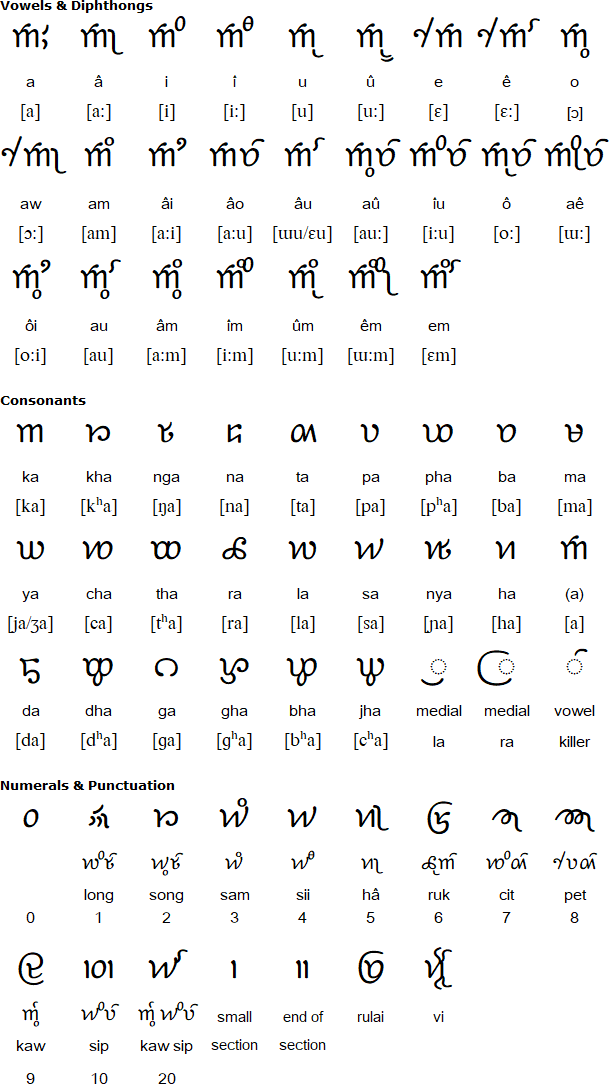Ahom, or Tai Ahom, is a Tai-Kadai language formerly spoken in the Indian state of Assam. The Ahom people originally came from Yunnan province in China. Ahom was used as the sole language of the Ahom kingdom until the 15th or 16th century, when it started to be replaced by Assamese.
By the early 19th century Ahom was no longer used as a spoken language, although it continued to be used in religious ceremonies throughout the 19th century, and since 1920 efforts have been made to revive the Ahom language and culture. One difficultly is that the phonology of Ahom was not recorded. An Ahom-Assamese-English Dictionary was published by G. Barua in 1920, and a number of other works in Ahom have been published since then, especially since 1997, when the first computer font for Ahom was developed by Stephen Morey.
The Ahom alphabet was probably derived from the Brahmi script. The earliest inscriptions, on a stone pillar, dates from the 15th century. The alphabet also appears on coins, brass plates and numerous manuscripts on cloth or bark.

Learn how to write and pronounce the Ahom alphabet:
Download an alphabet chart for Ahom (Excel)

Source: http://www.sealang.net/archives/ahom/
Information about Ahom | Numbers
Information about the Ahom language and alphabet
http://en.wikipedia.org/wiki/Ahom_language
http://std.dkuug.dk/jtc1/sc2/wg2/docs/n3928.pdf
http://www.sealang.net/archives/ahom/
http://brahmaputra.ceh.vjf.cnrs.fr/bdd/IMG/pdf/Ahom_Primer-1.pdf
Ahom, Aiton, Bouyei, Isan, Kam, Khamti, (Tai) Khün, Lao, Lue, Northern Thai (Kam Mueang), Nùng, Shan, Sui, Tai Dam, Tai Dón, Tai Hongjin, Tai Laing, Tai Nuea, Tai Phake, Tai Ya, Tai Yo, Thai, Thai Song, Yang Zhuang, Zhuang
Ahom, Aima, Arleng, Badagu, Badlit, Basahan, Balinese, Balti-A, Balti-B, Batak, Baybayin, Bengali, Bhaiksuki, Bhujimol, Bilang-bilang, Bima, Blackfoot, Brahmi, Buhid, Burmese, Carrier, Chakma, Cham, Cree, Dehong Dai, Devanagari, Dham Lipi, Dhankari / Sirmauri, Ditema, Dives Akuru, Dogra, Ethiopic, Evēla Akuru, Fox, Fraser, Gond, Goykanadi, Grantha, Gujarati, Gunjala Gondi, Gupta, Gurmukhi, Halbi Lipi, Hanifi, Hanuno'o, Hočąk, Ibalnan, Incung, Inuktitut, Jaunsari Takri, Javanese, Kaithi, Kadamba, Kamarupi, Kannada, Kawi, Kharosthi, Khema, Khe Prih, Khmer, Khojki, Khudabadi, Kirat Rai, Kōchi, Kodava Lipi, Komering, Kulitan, Kurukh Banna, Lampung, Lanna, Lao, Lepcha, Limbu, Lontara/Makasar, Lota Ende, Magar Akkha, Mahajani, Malayalam, Meitei (Modern), Manpuri (Old), Marchen, Meetei Yelhou Mayek, Meroïtic, Masarm Gondi, Modi, Mon, Mongolian Horizontal Square Script, Multani, Nandinagari, Newa, New Tai Lue, Ojibwe, Odia, Ogan, Pahawh Hmong, Pallava, Phags-pa, Purva Licchavi, Qiang / Rma, Ranjana, Rejang (Kaganga), Sasak, Savara, Satera Jontal, Shan, Sharda, Sheek Bakrii Saphaloo, Siddham, Sinhala, Sorang Sompeng, Sourashtra, Soyombo, Sukhothai, Sundanese, Syloti Nagri, Tagbanwa, Tai Noi, Takri, Tamil, Tanchangya (Ka-Pat), Tani, Thaana, Telugu, Thai, Tibetan, Tigalari, Tikamuli, Tocharian, Tolong Siki, Vatteluttu, Warang Citi
Page last modified: 16.03.23
[top]
You can support this site by Buying Me A Coffee, and if you like what you see on this page, you can use the buttons below to share it with people you know.

If you like this site and find it useful, you can support it by making a donation via PayPal or Patreon, or by contributing in other ways. Omniglot is how I make my living.
Note: all links on this site to Amazon.com, Amazon.co.uk
and Amazon.fr
are affiliate links. This means I earn a commission if you click on any of them and buy something. So by clicking on these links you can help to support this site.
[top]